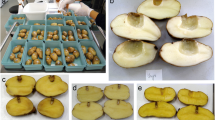Abstract
World wide potato production has been increasing steadily, both in acreage and yield. The most rapid expansion has been in developing countries (CIP 1985). Part of the reason for the crop’s increased popularity is its high per acre yield in calories and nutritive value compared to cereals and pulses (Neiderhauser 1993). Bacterial wilt, also known as brown rot of potatoes, is a chronic problem in the tropics and sub-tropics, and often limits potato production in those areas. S. phureja has been a valuable source of resistance to the disease but this resistance is unfortunatly temperature sensitive and is best suited to higher elevations or cooler climates (French et al 1982).
Access this chapter
Tax calculation will be finalised at checkout
Purchases are for personal use only
Preview
Unable to display preview. Download preview PDF.
Similar content being viewed by others
References
Alam Z, (1985) Screening of Solanum species against Alternaría solani. Pakistan J Agric Res 6:180 – 182
CIP Annual Report (anonymous) (1985) Potatoes in developing countr food systems. pp. 133 – 143
Devi LR, Menon MR, Aiyer RS (1982) Population threshold of Pseudomonas solanacearum at the onset of first symptoms of wilt in tomato. Indian J of Microbiol 22:41 – 43
French ER, De Lindo L (1982) Resistance to Pseudomonas solanacearum in potato: specificity and temperature sensitivity. Phytopathol 72:1408 – 1412
Hanneman REJr., Bamberg JB (1986) Inventory of tuberbearing Solanum species. Univ Wisconsin, Madison Wisconsin Bull 533
Johnston SA, Hanneman REJr. (1981) The discovery of additional one endosperm balance number (EBN) in diploid Solanum species. Amer Potato J 58:505 – 506 (abstract)
Kim H, Coi SU, Chae MS, Weilgus SM, Helgeson JP (1993) Identification of somatic hybrids produced by protoplast fusion between Solanum commersonii and S. tuberosum haploid. Korean J Plant Tissue Culture 20:337 – 344
Moffett L, Wood BA (1984) Populations of Pseudomonas solanacearum biovar 3 in naturally infested soil. Soil Biol Biochem 16:57 – 61
Montanelli C, Chiari A, Chiari T, Stefanini F, Nascali G (1995) Evaluation of resistance to Pseudomonas solanacearum in potato under controlled conditions. Euphyt 81:35 – 43
Neiderhauser JS (1993) International cooperation and the role of the potato in feeding the world. Amer Potato J 70:385 – 403
Olefir W (1974) Study of wild potato species for resistance to Ditylenchus dipsaci. Kartoplyarstvo. Resp. mizhvid. temat. nauk. zb. 5:13 – 17
Reddick D (1930) Frost-tolerant and blight-resistant potatoes. Phytopath 20:987 – 991
Sawicka E(1971) Development of parental lines for breeding potatoes with high starch contents. (Synteza materialow wyjsciowych dia hodowli ziemniakow wysokoskrobiowych). Problemy hodowli ziemniaka. Materialy z konferencjiz organizowanej przez Zaklad Genetyki i Syntezy Materialow Wyjsciowych Instytutu Ziemniaka 3 – 5 luty 1970 r. Radziejowice. Zeszyty Problemowe Postepow Nauk Rolniczych 67 – 80
Sklyarova NP (1970) The choice and genetic evaluation of potato species and hybrids for resistance to virus Y Tr N II kartof kh va. 7:52 – 57
Stefan K (1980) The problem of potato resistance to Ditylenchus destructor. (Zagadnienie odpornosci ziemniakow na porazenie przez Ditylenchus destructor). Zeszyty Problemowe Postepow Nauk Rolniczych 232:55 – 61
Tozzini AC, Ceriani MF, Saladrigas MV, Hopp HE (1991) Extreme resistance to infection by potato virus X in genotypes of wild tuber-bearing Solanum species. Potato Res 34:317 – 324
Editor information
Editors and Affiliations
Rights and permissions
Copyright information
© 1998 Springer-Verlag Berlin Heidelberg
About this chapter
Cite this chapter
Laferriere, L.T., Helgeson, J.P., Allen, C. (1998). Solanum tuberosum — S. commersonii Somatic Hybrids are Resistant to Brown Rot Caused by Ralstonia solanacearum . In: Prior, P., Allen, C., Elphinstone, J. (eds) Bacterial Wilt Disease. Springer, Berlin, Heidelberg. https://doi.org/10.1007/978-3-662-03592-4_47
Download citation
DOI: https://doi.org/10.1007/978-3-662-03592-4_47
Publisher Name: Springer, Berlin, Heidelberg
Print ISBN: 978-3-642-08361-7
Online ISBN: 978-3-662-03592-4
eBook Packages: Springer Book Archive




